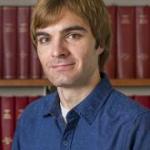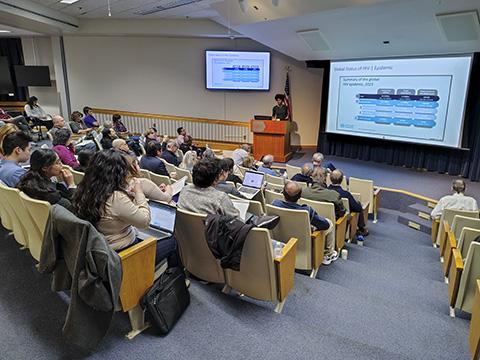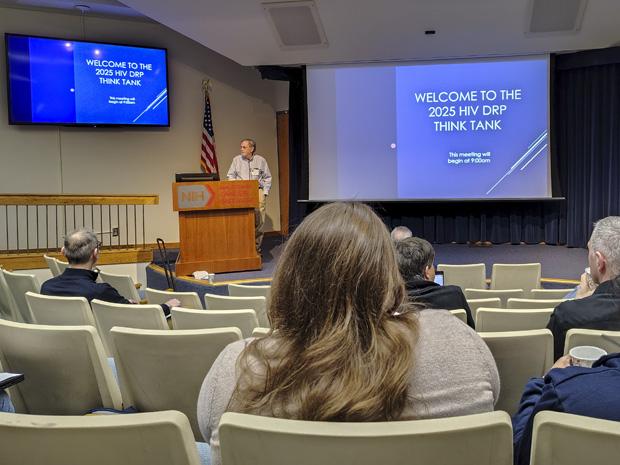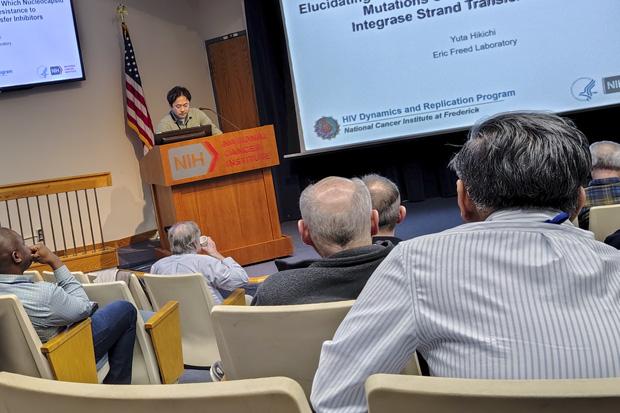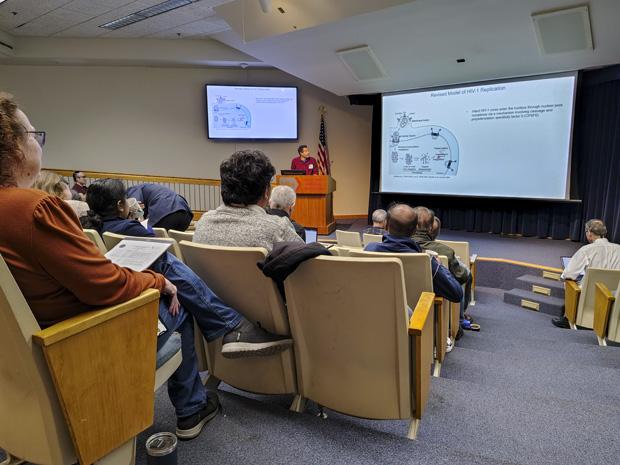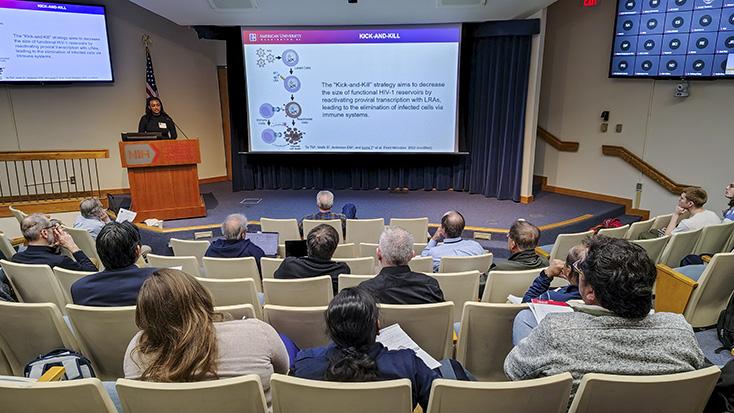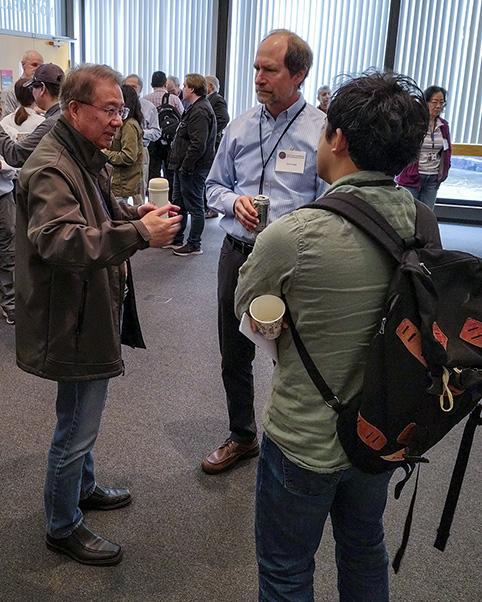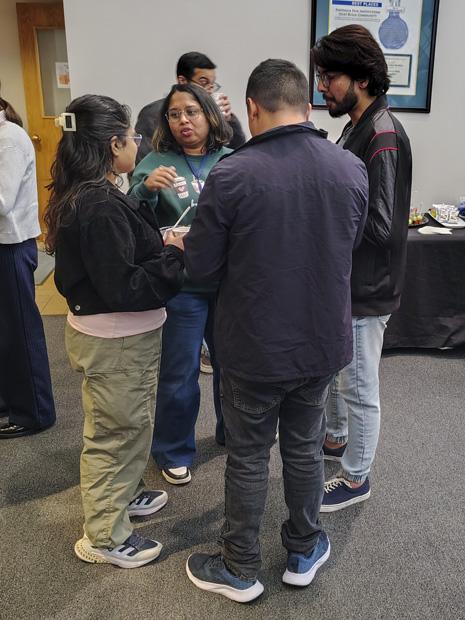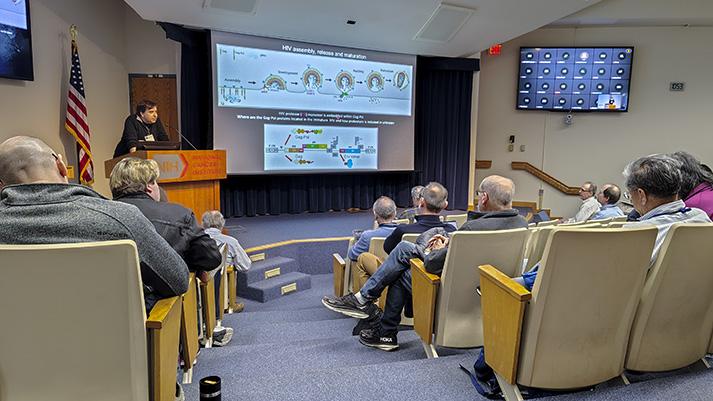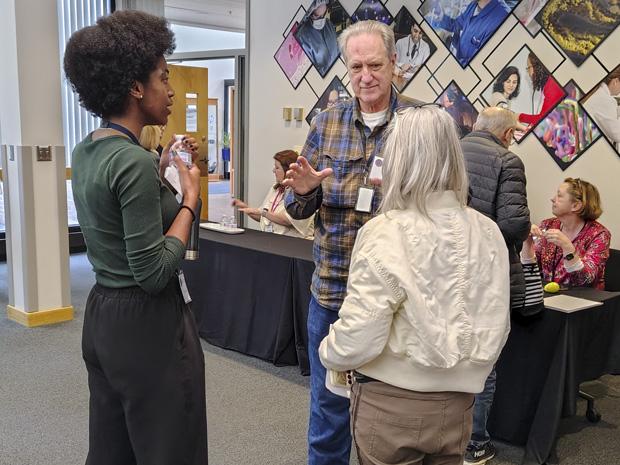NCI Postbaccalaureate fellow Alana Thomas was thrilled to attend the HIV DRP Think Tank for her second time. Professor John Coffin, Ph.D., was attending for his 27th time—and was no less thrilled.
Looking on, it was easy to see why.
The 27th HIV Dynamics and Replication Program (DRP) Think Tank, hosted by NCI Frederick, was a decidedly intimate gathering as far as scientific meetings go. The 18 short lectures and small guest list played a part in that—just over 130 scientists attended this year, most of them federal or National Laboratory employees—but more pervasive was the current of passion and tight-knit camaraderie.
Several in the audience were senior scientists who’ve stood shoulder-to-shoulder against HIV since the early years of science’s battle against the virus, each with a lifetime of knowledge and war stories to tell. Many others in attendance were those who’ve readily taken up the cause in the intervening decades: staff scientists or postbaccalaureate and postdoctoral fellows, eager to share, listen, and learn.
Thomas is part of the latter group, a fellow marking her first year with the HIV DRP. After watching the live videocast of last year’s meeting, she was excited to be researching in the field, she said.
“I think [attending the Think Tank] is great on two prongs because once you’re sort of in the research, getting to have the discussion with colleagues and people who have been in the field so much longer than me, and then also beforehand [when I wasn’t yet in the field], coming from the outside, just getting to see what there is to learn about and explore,” she said.
Sparking Ideas Among Early-Career and Established Researchers
This year’s meeting brought her a chance to lecture on some of her research: an examination of the HIV reservoir—a pool of virus with the potential to reignite infection if treatment is stopped. Her study examined cases in which the virus was found hiding in the brains of two deceased people who had HIV, adding to growing evidence that the brain can serve as a reservoir.
The possibility of a brain reservoir is an emerging area of research. Thomas’ lecture sparked a nearly 15-minute question-and-answer (Q&A) session, the longest and liveliest of the event.
Coffin, a professor at Tufts University and the founding director of the HIV DRP (a role he stepped down from in 2005), fittingly was one of the first to speak up, posing a question about methods. Thomas answered with panache.
Regarded as a respected elder statesman in HIV research, Coffin helped to establish the Think Tank in 1997. (The event was skipped a few years due to extenuating circumstances, he explains.) For him, attending the lectures each year—seeing the growth of ideas and the current of mentorship—is like watching the flourishing of fruits of decades of effort.
“I can put my finger on a lot of collaborations that have come out of this meeting,” he said. “It was originally started when the DRP was brand new.”
A Focus on the Future
Over the years, the event has changed along with the science, Coffin said.
The focus of the day was on progressing the science into the future. Talks concluded with ideas for next steps, with much of the Q&A focused on refining the science or considering possible connections and collaborations.
There was convivial discussion throughout the day, with everyone taking notes and chatting to colleagues between presentations and during breaks. Junior and senior scientists traded thoughts and theories together. Even online participants—nearly half of this year’s audience—were engaged, asking questions during each Q&A segment.
Many participants find the event and these interactions so valuable they attend year after year. Presenters come from NCI, Frederick National Laboratory for Cancer Research, and the National Institute of Allergy and Infectious Diseases, but also outside institutions, some local and others from as far away as Utah.
Among them, Vladimir Majerciak, Ph.D., an associate staff scientist in the HIV DRP, notes that he attends annually because the event “is always great and well-organized. … And it is always fun.”
Majerciak presented on mechanisms that suppress viral translation into a host’s genetic machinery, an area with implications for understanding and preventing the spread of infection. Like Thomas’ lecture and others, his research spurred an engaging Q&A session, with the discussion extending to lively exchanges with Majerciak and between audience members.
The spirited exchange is what Majerciak appreciates about the Think Tank—and epitomizes the passion that brings so many scientists back every year.
“This event brings the whole community together for exchanging ideas, networking, and in general to celebrate the science done here at NIH and by our collaborators and friends in the [D.C., Maryland, and Virginia] area,” he said.


